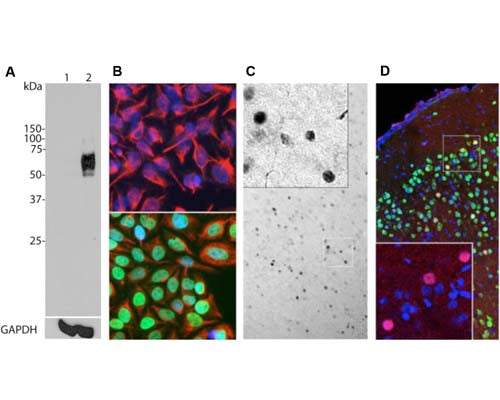Anti-Cellular oncogene fos (c-Fos) Antibody (2H2)
Our Anti-Cellular oncogene fos (c-Fos) mouse monoclonal primary antibody detects bovine, chicken, horse, human, mouse, pig, and rat Cellular oncogene fos (c-Fos), and is affinity-purified. It is validated for use in ICC, IHC-Frozen.


![Left: Rat hippocampus stained for c-FOS (red) by Immunohistochemistry. Section was co-stained with rabbit antibody to FOX3/NeuN (R-3770-100, green). Blue: DAPI nuclear stain. The hippocampal neurons stain green for FOX3/NeuN and a few also are expressing c-FOS, and thus appear orange. These cells were spontaneously active at the time the animal was sacrificed. Right: Western blot analysis of c-FOS expression (green) in cell lysates. Mouse antibody to c-FOS was used at 1:1,000 dilution. GAPDH (red, lanes 2-5) was used as loading control (rabbit antibody to GAPDH, R-1701-100, 1:20,000). [1] protein standard, [2] HeLa cells in serum free media, [3] HeLa cells stimulated with 20% FBS for 2 hours after 36 hours serum starvation, [4] rat cortical neurons, [5] rat cortical neurons treated with membrane depolarization buffer for 5 hours. Multiple bands at 50-65 kDa in stimulated or treated cell lysates correspond to different forms of the c-Fos protein. The single band at 37 kDa (red) represents GAPDH protein.](http://www.antibodiesinc.com/cdn/shop/files/m-1752-100-wb-ihc-2_120x120.jpg?v=1759273489)
A: Western blot analysis of c-Fos expression in HeLa cells using M-1752-100. HeLa cells were serum-starved for 36 hours (Lane 1). Serum-starved HeLa cells were stimulated with 20% FBS for 2 hours (Lane 2). M-1752-100 recognizes bands in the range of 50-65 kDa, which represent multiple forms of c-Fos. A loading control was performed by stripping and re-probing the membrane with a monoclonal antibody against GAPDH, M-1376-250.
B: Immunofluorescence staining of HeLa cells with M-1752-100. c-Fos staining (green) only localizes in the nuclei of 20% FBS stimulated cells (bottom panel), but not in un-stimulated cells (top panel). Cells were counter-stained with Chicken polyclonal antibody against vimentin, C-1409-50 (red) and DAPI (blue).
C: Immunohistochemistry using M-1752-100 on 4% PFA transcardial-perfused mouse brain sections (45 uM thickness). c-FOS immunoreactive cells (dark colour, localized in cell nucleus) were visualized using a standard HRP-DAB (horseradish peroxidase-3,3'-diaminobenzidine) staining technique.
D: Immunohistochemistry using M-1752-100 (red) and Rabbit polyclonal anti-NeuN/Fox3 (R-3770-100, green) on mouse cortical sections. Neurons positive for c-Fos and Fox3/NeuN appear yellow. The insert shows an enlarged image of staining with M-1752-100. Nuclei were labeled with DAPI (blue).
Click on image to zoom
B: Immunofluorescence staining of HeLa cells with M-1752-100. c-Fos staining (green) only localizes in the nuclei of 20% FBS stimulated cells (bottom panel), but not in un-stimulated cells (top panel). Cells were counter-stained with Chicken polyclonal antibody against vimentin, C-1409-50 (red) and DAPI (blue).
C: Immunohistochemistry using M-1752-100 on 4% PFA transcardial-perfused mouse brain sections (45 uM thickness). c-FOS immunoreactive cells (dark colour, localized in cell nucleus) were visualized using a standard HRP-DAB (horseradish peroxidase-3,3'-diaminobenzidine) staining technique.
D: Immunohistochemistry using M-1752-100 (red) and Rabbit polyclonal anti-NeuN/Fox3 (R-3770-100, green) on mouse cortical sections. Neurons positive for c-Fos and Fox3/NeuN appear yellow. The insert shows an enlarged image of staining with M-1752-100. Nuclei were labeled with DAPI (blue).
SKU: M-1752-100
Ships: 1-2 business days
Product Details
Cellular oncogene fos (c-Fos)
FUNCTION: Nuclear phosphoprotein which forms a tight but non-covalently linked complex with the JUN/AP-1 transcription factor. In the heterodimer, FOS and JUN/AP-1 basic regions each seems to interact with symmetrical DNA half sites. On TGF-beta activation, forms a multimeric SMAD3/SMAD4/JUN/FOS complex at the AP1/SMAD-binding site to regulate TGF-beta-mediated signaling. Has a critical function in regulating the development of cells destined to form and maintain the skeleton. It is thought to have an important role in signal transduction, cell proliferation and differentiation. In growing cells, activates phospholipid synthesis, possibly by activating CDS1 and PI4K2A. This activity requires Tyr-dephosphorylation and association with the endoplasmic reticulum. SUBUNIT: Heterodimer. Interacts with DSIPI; this interaction inhibits the binding of active AP1 to its target DNA. Interacts with MAFB. SUBCELLULAR LOCATION: Nucleus. INDUCTION: C-fos expression increases upon a variety of stimuli, including growth factors, cytokines, neurotransmitters, polypeptide hormones, stress and cell injury. SIMILARITY: Belongs to the bZIP family. Fos subfamily. SIMILARITY: Contains 1 bZIP domain (Ref: uniprot.org).
Affinity-purified
Monoclonal
2H2
IgG1
ICC, IHC
Mouse
see application details
Full length, E.coli-derived recombinant human c-FOS protein.
Human
Bovine, Chicken, Horse, Human, Mouse, Pig, Rat
Spin vial briefly before opening. Reconstitute with 100 µL sterile-filtered, ultrapure water to achieve a 1 mg/mL concentration. Centrifuge to remove any insoluble material. Store lyophilized, unopened vial at 2-8°C or lower. After reconstitution, prepare aliquots and store at -20°C for a higher stability. Avoid freeze-thaw cycles.
Lyophilized
Protein G purified
Lyophilized from PBS buffer pH 7.2-7.6 with 0.1% trehalose, and sodium azide
WB: 0.5-1 µg/mL
IHC: 1-2 µg/mL
ICC: 1-2 µg/mL
IHC: 1-2 µg/mL
ICC: 1-2 µg/mL
IHC: This antibody has been shown to work on 4% PFA fixed mouse brain sections.
Western blotting (WB): This antibody detects bands between 50-65 kDa, which only appear in stimulated cells.
Western blotting (WB): This antibody detects bands between 50-65 kDa, which only appear in stimulated cells.
Unconjugated
Human. Horse, cow, pig, chicken, rat, mouse.
For research use only.
United States
12 months after date of receipt (unopened vial).
Cellular oncogene fos; G0/G1 switch regulatory protein 7; cFOS
25°C (ambient)


